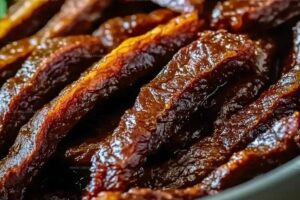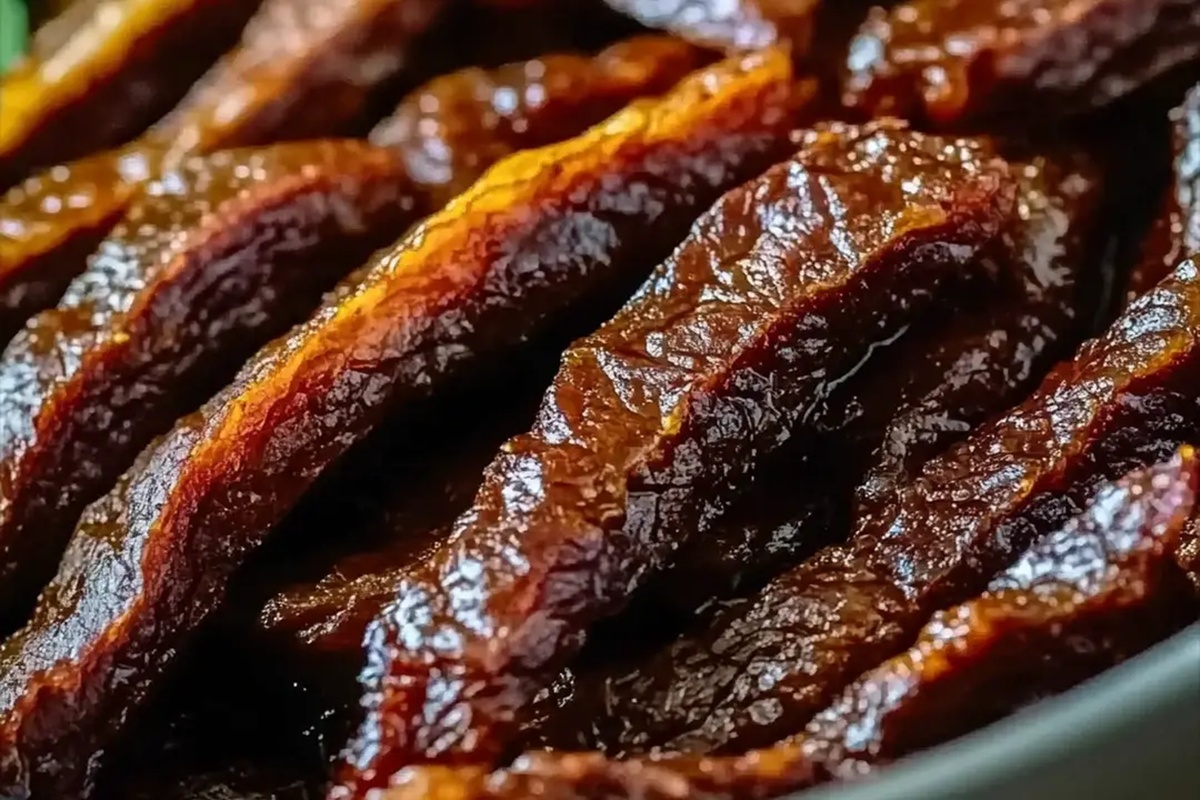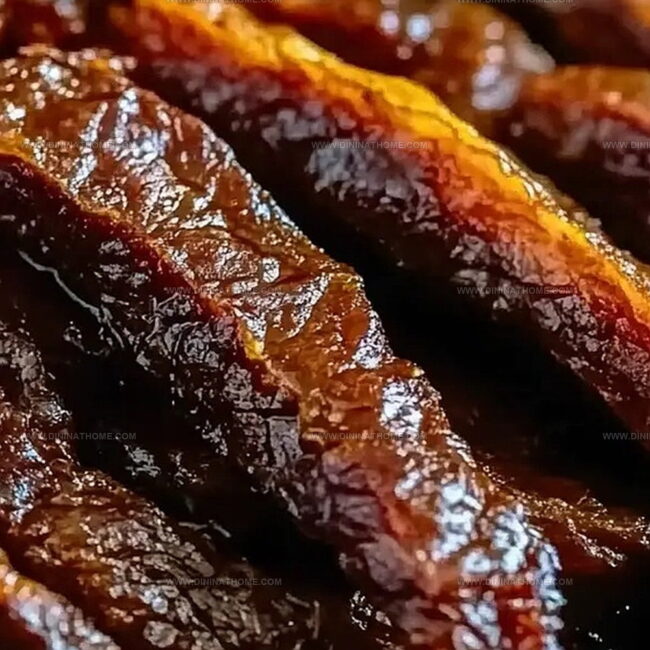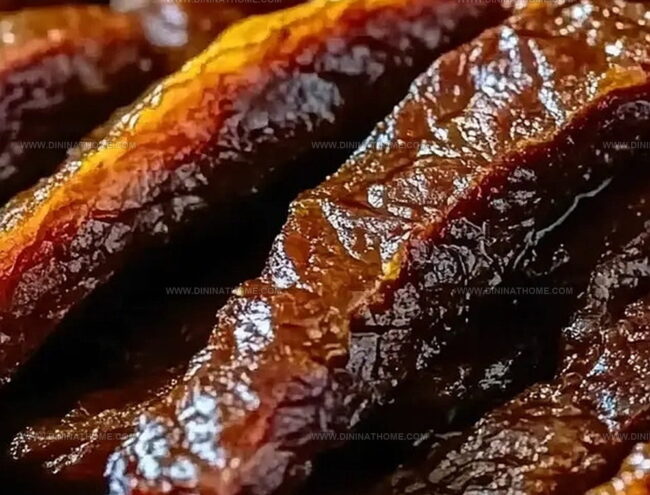The Easiest Air Fryer Beef Jerky Recipe for Homemade Goodness
Crafting homemade air fryer beef jerky can be a delightful weekend adventure for snack enthusiasts.
Meat lovers appreciate how quickly this method transforms lean cuts into protein-packed treats.
Quality beef strips become crispy, flavor-packed morsels with minimal effort.
Selecting the right cut matters tremendously for achieving that perfect chewy texture.
Marinating techniques play a crucial role in developing deep, complex flavors.
Spice blends can range from classic pepper and garlic to more adventurous combinations like smoky chipotle or zesty teriyaki.
Beef Jerky In The Air Fryer That’s Tender, Savory, And So Easy
What You’ll Use in Air Fryer Beef Jerky Recipe
Protein Base:Marinade Liquid Base:Sweetener:Dry Spices:Kitchen Tools:Beef Jerky in the Air Fryer – Step-by-Step
Step 1: Slice the Beef
Select a lean cut of beef like top round or flank steak.
Using a sharp knife, cut the beef into ultra-thin strips against the grain.
Thin, uniform slices ensure even drying and consistent texture throughout the jerky.
Step 2: Create Flavor-Packed Marinade
In a large mixing bowl, combine the following ingredients:Whisk all ingredients until they form a smooth, well-blended marinade.
Step 3: Marinate the Beef
Submerge beef strips completely in the marinade.
Cover the bowl with plastic wrap and refrigerate.
Allow the meat to soak up the flavors for a minimum of 4 hours, though overnight marination delivers the most intense taste profile.
Step 4: Prepare the Air Fryer
Preheat your air fryer to 160°F.
This low temperature helps dry the meat slowly without cooking it traditionally.
Step 5: Arrange Beef Strips
Remove beef from the marinade and gently pat each strip dry using paper towels.
Arrange strips in a single layer inside the air fryer basket, ensuring no pieces overlap or touch each other.
Step 6: Dry the Jerky
Cook the beef strips for 2 to 3 hours.
Flip the strips halfway through the cooking process to ensure even drying.
The jerky is ready when it looks dry but remains slightly flexible when bent.
Step 7: Cool and Package
Allow the jerky to cool completely at room temperature.
Transfer to an airtight container or vacuum-sealed bag.
Properly stored jerky remains fresh for 2 weeks at room temperature or up to 3 months when refrigerated.
Jerky-Making Tips for Flavorful Air Fryer Results
Store Air Fryer Beef Jerky Properly
Drinks and Snacks with Air Fryer Beef Jerky
Air Fryer Jerky Flavor Experiments
FAQs
Lean cuts like top round, bottom round, or flank steak are ideal because they have minimal fat, which can make jerky spoil faster. Trim any visible fat before slicing to ensure a longer-lasting and better-tasting jerky.
Aim for consistent strips about 1/8 inch thick, always cutting against the grain. This ensures tenderness and helps the meat dry evenly in the air fryer, creating a more uniform texture throughout the jerky.
Removing excess moisture helps achieve a crispier texture and allows the beef to dehydrate more effectively. Excess liquid can prevent the jerky from developing that classic dry, chewy consistency that makes jerky so enjoyable.
The jerky should bend without breaking but shouldn’t be soft or moist. When you bend a piece, it should crack slightly but not snap completely in half. This indicates it’s perfectly dried and ready to be enjoyed.
Print
Air Fryer Beef Jerky Recipe
- Total Time: 7 hours 20 minutes
- Yield: 4 1x
Description
Homemade air fryer beef jerky delivers bold protein-packed snacking perfection for meat enthusiasts. Lean beef strips seasoned with spices create a delicious, protein-rich treat you can easily prepare at home.
Ingredients
Main Protein:
- 1 lb (454 grams) lean beef (flank steak, sirloin, or round steak)
Liquid Marinade Ingredients:
- 1/4 cup (60 milliliters) soy sauce
- 2 tablespoons (30 milliliters) Worcestershire sauce
- 1 tablespoon (15 milliliters) apple cider vinegar
- 1 tablespoon (15 milliliters) honey
Dry Seasoning Ingredients:
- 1 teaspoon garlic powder
- 1 teaspoon onion powder
- 1/2 teaspoon black pepper
- 1/2 teaspoon smoked paprika
- 1/2 teaspoon ground mustard (optional)
- 1/4 teaspoon red pepper flakes (optional, for heat)
Instructions
- Meticulously trim the beef, slicing against the grain to ensure maximum tenderness, creating uniform strips approximately 1/8 inch thick.
- Craft a robust marinade by whisking together soy sauce, Worcestershire sauce, honey, garlic powder, onion powder, black pepper, smoked paprika, red pepper flakes, apple cider vinegar, and ground mustard into a harmonious blend.
- Immerse the beef strips completely in the marinade, ensuring each piece is thoroughly coated. Seal the container and refrigerate for a minimum of 4 hours, allowing flavors to penetrate deeply, with overnight marination recommended for optimal taste development.
- Configure the air fryer to a low temperature of 160°F, creating an ideal environment for slow dehydration without compromising meat quality.
- Carefully extract beef strips from the marinade, gently patting each piece dry with paper towels to eliminate excess moisture and promote crispier texture.
- Strategically arrange beef strips in a single layer within the air fryer basket, maintaining minimal overlap to facilitate even drying and consistent airflow.
- Initiate the dehydration process, air frying for 2-3 hours. Midway through cooking, carefully flip the strips to ensure uniform moisture removal.
- Monitor jerky’s progression, checking for desired doneness – the ideal texture should be dry yet retain a slight flexibility when bent.
- Allow jerky to cool completely at room temperature, then transfer to an airtight container or vacuum-sealed bag for preservation.
- Store in a cool, dark place for up to 2 weeks at room temperature, or extend shelf life by refrigerating for up to 3 months.
Notes
- Choose lean beef cuts like top round or bottom round for the leanest, most tender jerky without excess fat.
- Slice meat against the grain to create softer, easier-to-chew jerky strips that break down more smoothly.
- Experiment with marinade ingredients by swapping honey with maple syrup or adding different spices like cayenne for extra heat.
- Pat beef strips completely dry before air frying to ensure crispy edges and prevent excess moisture during cooking process.
- Prep Time: 4 hours 20 minutes
- Cook Time: 3 hours
- Category: Snacks
- Method: Air Frying
- Cuisine: American
Nutrition
- Serving Size: 4
- Calories: 200
- Sugar: 2 g
- Sodium: 800 mg
- Fat: 8 g
- Saturated Fat: 3 g
- Unsaturated Fat: 4 g
- Trans Fat: 0 g
- Carbohydrates: 6 g
- Fiber: 0 g
- Protein: 30 g
- Cholesterol: 70 mg




James Walker
Lead Recipe Developer & Culinary Educator
Expertise
Southern Cuisine & Farm-to-Table Cooking, Recipe Development & Testing, Culinary Education & Instruction
Education
School: Auguste Escoffier School of Culinary Arts
Program: Diploma in Culinary Arts and Operations
Focus: Comprehensive training in classical and modern culinary techniques, kitchen operations, and farm-to-table practices.
James didn’t learn cooking from a TV show, he learned it from busy kitchens, family gatherings, and long afternoons spent testing recipes the hard way.
After training at the Auguste Escoffier School of Culinary Arts, he brought his love for real, down-to-earth food to every dish he makes.
At Dining At Home, James loves building recipes that feel familiar but still have something special, like adding a twist to a classic or making a slow Sunday dinner feel brand new.
When he’s not in the kitchen, you’ll probably find him swapping garden tips at the farmers’ market or teaching his daughter how to flip pancakes without a mess (almost).